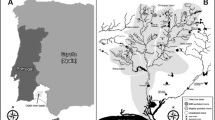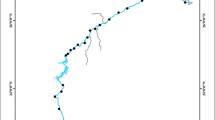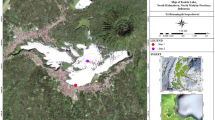Abstract
Diatoms have been sampled in several types of water bodies in the province of Overijssel for a period of five years. Samples from 333 sites were examined both in spring and autumn. Extensive analysis of physico-chemical variables was carried out.
Data were processed by multivariate analysis for detecting correlations between species and environmental factors. Both ordination and clustering techniques were used. Statistical tests were performed to evaluate environmental relationships.
The main factors in this study appear to be pH, nutrient pollution (saprobity and trophic degree) and alkalinity. Within the group of waters which is not influenced by extreme conditions of pH or pollution, there is a discrepancy between waters with low and high alkalinity.
The present study confirms that diatoms are useful indicators of pollution and pH, as well documented by several authors. Diatoms are also suitable as biological indicators for alkalinity at least on a regional scale. This offers possibilities for the use of diatoms in monitoring studies, especially in waters that are still under relatively low environmental stress. It also offers opportunities for setting ecological standards, based on the characteristics of non-polluted water bodies. This aspect will be of interest to the water management policy in the province of Overijssel.
Similar content being viewed by others
References
Arts, G. H. P., 1988. Waterverzuring in Overijssel. Laboratorium voor Aquatische Ecologie, Katholieke Universiteit Nijmegen, 59 pp.
Braun-Blanquet, J., 1964. Planzensoziologie. Gründlagen der Vegetationskunde. Springer Verlag, Wien, 865 pp.
Hill, M. O., 1979. TWINSPAN — A FORTRAN program for arranging multivariate data in a ordered two-way table by classification of the individuals and attributes. Ithaca, New York, 90 pp.
Jongman, R. H. G., C. J. F. ter Braak & O. F. R. van Tongeren, 1987. Data analysis in community and landscape ecology. PUDOC, Wageningen, 299 pp.
Krammer, K. & H. Lange-Bertalot (1986–1991). Bacillariophyceae. Süsswasserflora von Mitteleuropa 2(1–4). Gustav Fisher Verlag, Stuttgart. 4 Vols.
Lange-Bertalot, H., 1978. Diatomeen-Differialarten anstelle von Leitformen: ein geeigneteres Kriterium der Gewässer-belastung. Archiv Hydrobiol., Suppl. 51: 393–427.
Lange-Bertalot, H., 1979a. Toleranzgrenzen und Populationsdynamik bentischer Diatomeen bei unterschiedlich starker Abwasserbelastung. Archiv Hydrobiol., Suppl 56: 184–219.
Lange-Bertalot, H., 1979b. Pollution tolerance of diatoms as a criterion for water qualtiy estimation. Nova Hedwigia, Beih. 64: 285–304.
Maasdam, R., J. H. ten Cate, R. M. M. Roijackers & E. K. van Mourik, 1992. Diatomeeëngezelschappen in Overijssel. Landbouwuniversiteit Wageningen, Provincie Overijssel, Zwolle, 97p.
Opdam, P., H. van Dam, S. M. ten Houte de Lange, J. T. R. Kalkhoven, F. Kragt & A. H. P. Stumpel, 1983. A comparative study of spatial patterns in a landscape. Annual report 1982, Research Institute for Nature Management, Leersum, 66–82.
Roos, C., J. P. P. Gardeniers, R. M. M. Roijackers & E. T. H. M. Peeters, 1991. Ecological assessment of Dutch inland waters: Philosophy and preliminary results. Verh. Internat. Verein. Limnol. 24: 2104–2106.
Smit, H., 1990. Hydrobiologisch onderzoek van kleinere wateren in Zuid-Holland. Provincie Zuid-Holland, Dienst Ruimte en Groen, Dienst Water en Milieu, Den Haag, 165 pp.
Ter Braak, C. J. F., 1987. CANOCO — A FORTRAN program for canonical community ordination by [partial][detrended] [canonical] correspondence analysis, principal component analysis and redundancy analysis (version 2.1). ITI-TNO, Wageningen, 95 pp.
Van Dam, H., 1987. Monitoring of chemistry, macrophytes, and diatoms in acidifying moorland pools. RIN-report 87/19. Research Institute for Nature Management, Leersum, 91 pp.
Van Dam, H., 1988. Acidification of three moorland pools in The Netherlands by acid precipitation and extreme drought periods over seven decades. Freshw. Biol., 20: 157–176.
Van Dam, H. & A. Mertens, 1989. Diatomeeën van oude en recente macrofyten van het Beuven in relatie tot beheer. Diatomededelingen 8: 15–20.
Van Dam, H. & A. Mertens, 1993. Diatoms on herbarium macrophytes as indicators of water quality. Hydrobiologia 269/270: 437–445.
Verdonschot, P. F. M., 1990. Ecological characterization of surface waters in the province of Overijssel (The Netherlands). Thesis Agricultural University, Wageningen, 255 pp.
Author information
Authors and Affiliations
Rights and permissions
About this article
Cite this article
ten Cate, J.H., Maasdam, R. & Roijackers, R.M.M. Perspectives for the use of diatom assemblages in the water management policy of Overijssel (The Netherlands). Hydrobiologia 269, 351–359 (1993). https://doi.org/10.1007/BF00028034
Issue Date:
DOI: https://doi.org/10.1007/BF00028034




